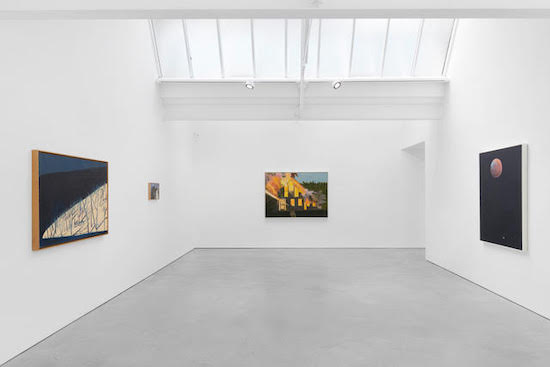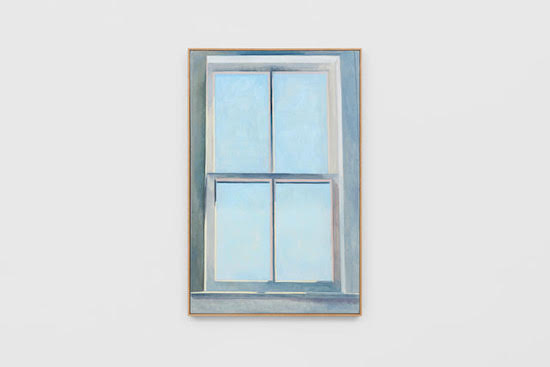Lois Dodd, Blue Sky Window, 1979, oil on linen, 142.2 x 91.4 cm, 56 x 36 ins. Photo: Ben Westoby. © Lois Dodd. Courtesy Modern Art, London & Alexandre Gallery, New York
This must be the coolest place in the city right now. With the disturbingly high temperatures in Britain of late, it feels good to be here amidst the quiet calm of Lois Dodd’s paintings. Dodd is now 92; she’s from New Jersey and was a founder of the Tanager Gallery, part of the 10th Street avant-garde scene in 1950’s NYC that also featured such luminaries as Alex Katz, Tom Wesselmann and Philip Pearlstein. Unlike those names Dodd (in common with many other women painters) has had to wait far too long for serious attention to be paid, at least in this country where this is – incredibly – her first exhibition.
The paintings here evidence a deliberation in vision; things are seen carefully and noted slowly and thought out. There is a neat paradox at work: how can such images, the results of a lengthy period of peaceful contemplation, seem so urgent? There is a particular stress on looking at and through windows here, what they frame and what they reflect. This is a seemingly lonely world with few figures, a solitary fireman aims a whooshing hose in Burning House, Night, with Fireman (2007), but humanity, as with Edward Hopper’s empty cityscapes, somehow always indicates its presence. There is an intimacy to Dodd’s work; the windows frame her world and it is through these that we too share her look out.
Despite living mainly in Manhattan for the best part of seventy years the paintings here are mainly of rural scenes and in particular the landscapes and buildings of coastal Maine. An image such as Ice in Window (1982) has its minty blue triangular shards obscuring the glass panes: a welcome relief from the boiling heatwave that burns outside the cool air-con of the gallery space. You want to bury your face in the cold white plains of Morning Snowfield (1983) with its stark lines of leafless trees. Dodd’s brushwork here is as naturally delicate as a Japanese scroll painting, there’s a shizen-style lack of pretence. And with Rainy Window, NYC (2014) the spermatozoon-like dribbling of droplets perfectly captures the near autistic pleasure of staring blankly out a window as it pours down. Rain? As the man sang: I don’t mind.
The silent insistence, the view that holds us spellbound at the wonders of the world, is captured with extreme economy in Blue Sky Window (1979). If there was an antithesis, a true rejoinder, to Marcel Duchamp’s (punning) blacked out Fresh Widow (1920) then this is it. With the shifting shades of blues and yellows on the frames we see Dodd telling us to look carefully again and again, that the eye has a lot more to tell us still, even a hundred years after Duchamp’s announcement of the apparent death of ‘retinal’ art.

Lois Dodd, exhibition view, Modern Art, Helmet Row, London, 6 July – 24 August 2019. Photo: Ben Westoby. Courtesy Modern Art, London & Alexandre Gallery, New York
The serial nature of her vision asks us to stare at yet another window but, hey, check how different this one is, what it reflects, what it sees. Of course, Monet gave us his lessons in repetition too but Dodd insists that there’s a lot more mileage in its execution.
Dodd’s focus on architectural detail directs the eye to the pleasurable geometries of a door held slightly ajar as with Front Door Cushing (1982). We are in a Maine village again. There is an exquisite capture of pattern and light with some lilac shadowing behind the door in brilliant contrast to the fast slashing blasts of green foliage outside. In Door Staircase (1981) we confront the ascending line of steps, each a variant of violet that deepens as it heads northwards from mauve, to gentian, ending in blue. The wood paneling of the clapboard is done in a primrose dawn tint. We are in a moment as evanescent as seeing a butterfly in flight and Dodd pins the instant with exigency.
Dodd painted en plein air and caught much that we bypass in our daily scuttling like the roof window detail of Dormer, Yellow + Blue + Lavender (1985). Again here she stresses the parallelograms and rectangles of changing light that we so easily miss. With Night House with Lit Window (2012) the bright yellow curtains shine through the darkness and promise comfort, a glowing image that radiates an optimism; a direct challenge to Hopper’s insistent sadness.
Yet another master is recalled by Red Curtains and Lace Plant (1978): a simple image of washing as it dries on a line in a breeze. The gusts waft the scarlet material and are reminiscent of the great nineteenth-century German realist Adolph Menzel with his own brilliance at capturing the decisive moment long before photographers got a hold of the idea.
And lastly Blue Bottle and House Eve (2016) renders the beautiful stasis, in simple markings of blue and lilac and grey, of another view out a window at the house opposite. Dodd, like Morandi before her, has an exceptional skill at conveying an essentially benign atmosphere and a hard won acceptance of what we are given.
She is not alone in being shamefully neglected. As with the brutal corporeal honesty of Maria Lassnig, the eerily perceptive portraits of Alice Neel, or the ecstatic sexual daring of Dorothy Iannone, rigorous evaluation and approval would appear to have arrived late in life for Dodd. Better late than never: it is a real belated joy to see her work on this side of the Atlantic.
Lois Dodd is on at Modern Art, Helmet Row, London until 24 August


